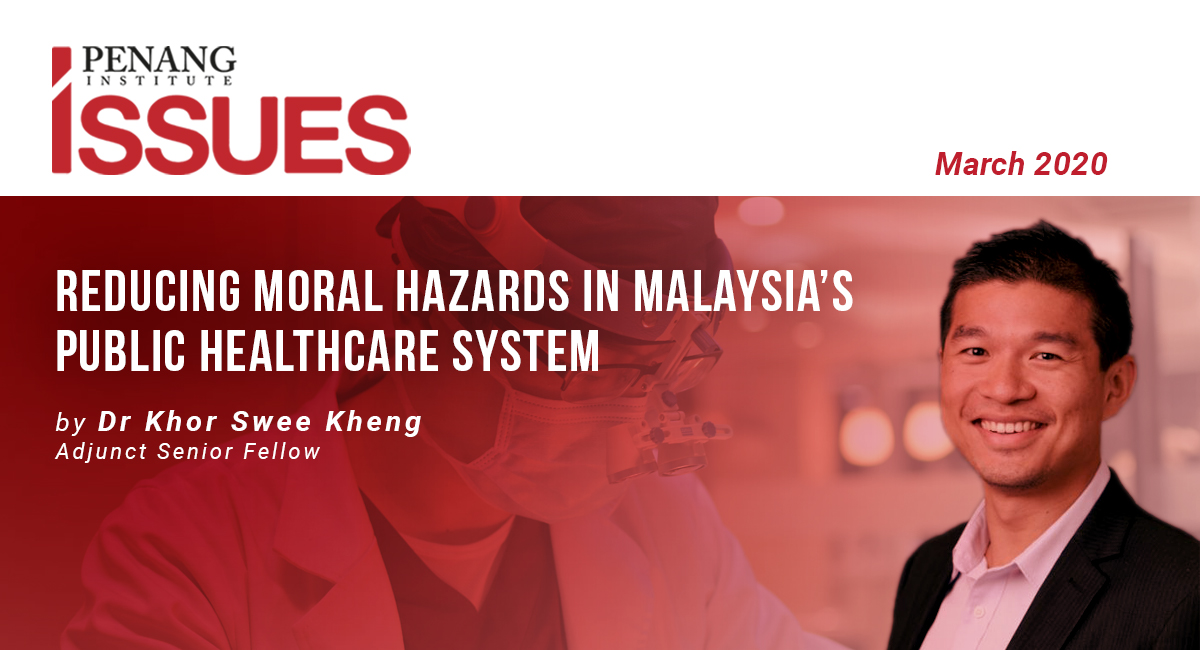Executive Summary
- Malaysia’s public healthcare system is well-respected internationally for its strong outcomes, easy access and low costs. However, moral hazards in the system must be tackled to continue delivering high-quality and fiscally sustainable public healthcare
- Moral hazards occur when an actor takes more risks because another actor bears the costs. In Malaysia public healthcare system, systematic wastage and inappropriate utilization from moral hazards occur because of misaligned physician incentive structures, overly low access fees, pressure from patients or superiors, defensive medicine, and a lack of checks and balances
- Managing moral hazards in Malaysia’s public healthcare system is a multi-year journey with a basket-of-solutions to gradually increase physician accountability and patient cost-consciousness, while managing the political realities of managing both constituencies
With public and policy attention firmly focused on visible causes of rising healthcare costs like ageing populations, expensive technology, and non-communicable diseases, moral hazards can appear irrelevant. However, their presence in Malaysia’s public sector is a slow-burning crisis both pressing and timeless.
This brief deconstructs the principal-agent problem and Malaysia’s healthcare system to understand its moral hazards, examines the weaknesses of current policies, and provides a basket of solutions to mitigate them.
The principal-agent problem[1] is also called the agency problem, and was first analysed in the 1970s by economists, political scientists, and game theorists. When an agent (the physician) decides or acts for a principal (the patient), there is a natural tendency to maximise their own outcomes at the expense of their patients. Where healthcare is concerned, the situation gets more complicated in two ways.
Firstly, classical economics only discusses two actors and excludes healthcare’s third actor: the payer, which in Malaysia[2] comprises the government, household out-of-pocket payments, and private insurers. Secondly, while a standard buy-sell transaction features the same Decision-Maker, Payer, and Consumer, a healthcare transaction features three separate entities: a physician deciding, the government paying, and a patient consuming an intervention[3].
Malaysia’s system has had socialist leanings with capitalistic efficiencies. Beveridge-style universal cover through a tax-funded single-payer system has existed since the 1960s, supplemented by the private sector. Tax collection is only 13% of GDP (vs the OECD35 average of 34%)[4] and healthcare spending is only 4% of GDP or $1040 per person (vs 9% or $4,003), with only 1.5 physicians/1000 people (vs 3.4). The public sector covers 65% of the population with only 53% of total healthcare spending and 45% of all physicians[2], who draw fixed (and lowish) monthly salaries and annual bonuses.
Problematically, the Ministry of Health (MOH) is simultaneously provider, payer, and regulator. Accessing the system requires a small fee which can dramatically increase for those facing catastrophic illness. Unsurprisingly, common complaints include long queues, over-crowding, and lack of specialists. Despite this, outcomes compare favourably to OECD35, with life expectancy of 75 years (vs 80) and infant deaths at 6.7/1000 live births (vs 3.9)[4].
Healthcare’s built-in principal-agent problem and Malaysia’s public sector contain moral hazards, which occur when an actor takes more risks because another actor bears the costs[5]. Physicians prescribe more (e.g. unnecessary antibiotics)[6] because someone else bears its financial or physiological effects, and because accountability is rare. Patients naturally demand more and dearer treatment because someone else pays for it, or even due to self-entitlement after paying access fees. In summary, these moral hazards create injustice through externalities that harm patients, reduce trust in the system, and unnecessarily increase utilisation.
This brief only focuses on moral hazards in the Malaysian public sector given its importance as a common good, impact on the public purse, and absence of meaningful internal constraints. This contrasts with the private sector, where private hospital fees are regulated[7] and private insurers impose deductibles or co-pays on patients, prescribe limits on physician interventions, and investigate fraud and abuse.
Systematic Wastage
Unfortunately, Malaysian public healthcare largely avoids directly addressing moral hazards. Rigorous professional training and licensing, ethics codes, clinical practice guidelines, senior approvals for costly interventions, and some outcomes auditing do mitigate the public sector physician’s disproportionate power, but exhibit two main weaknesses.
Firstly, they tackle the symptoms but not the root causes of incentives for physicians and patients. Secondly, they have insufficiently strengthened patients, payers, and market forces.
Currently, physicians are held accountable for a narrow subset of health performance measurements[8], with only clinical outcomes measured during morbidity and mortality reviews, or occasionally litigation. With no accountability for intervention rates (e.g. frequency of Caesarean sections, CT scans for trauma, or antibiotics for routine influenza) or reasonable budgetary targets, physicians continue behaving as though they possess unlimited resources. In this author’s personal experience, wastage is widespread even among senior doctors who think nothing of ordering two blood tests when one suffices[9]. There is a palpable absence even of uncontroversial health economics training for medical students and physicians, communication about utilisation and costs in physicians’ work units, and its comparisons with peer groups. When everyone is incentivized to focus only on clinical outcomes, even physician-administrators ignore how many interventions were performed by their unit last year, much less how many were truly needed or their total cost.
Malaysia’s user access fees encourage personal responsibility for health. However, its design is unfair and ineffective. An invisible majority have almost zero responsibility to pay for common diseases, and a visible minority suddenly fall off a financial cliff with rare ones. Fees for almost unlimited interventions as a public sector outpatient are unchanged since 1982[10] at only RM1 (£0.19)[11] to see a general practitioner or RM5 for a specialist. With those rates, Malaysians believe that treatment is cheap and budgets are limitless. However, someone needing open heart surgery or knee replacement must purchase the expensive valves and implants themselves. Inconsistently, the government pays for some medicines in the same price range as those devices. Fortunately for poor citizens at any point-of-care, all charges are waived after means-testing by relevant agencies[12] or simply using the honour system[13]. None of this accounts for the 607% increase in healthcare spending (1997-2014)[2], 248% growth in the Consumer Price Index (1982-2017)[14], and the current national debt of 80% of GDP[15].
In other countries, informed patients[16], empowered payers, and market forces check physician power in the public sector. In Malaysia, absent policies weaken these three actors.
Firstly, the physician-patient information asymmetry is still too large in a hierarchical and paternalistic society. Secondly, the MOH’s Health Technology Assessment Section (HTAS)[17] has only 34 permanent staff and is politically under-capitalised, with senior physicians still swaying reimbursement decisions. Finally, the MOH’s conflicting triple roles and lack of market forces protect themselves from meaningful oversight and competition, creating a lumbering behemoth operating a monopolistic command-economy public healthcare system.
A New Healthcare Social Contract
Therefore, Malaysia needs a new healthcare social contract with better policies targeting moral hazards. Successfully implementing a basket of politically-acceptable solutions today allows more ambitious reform tomorrow, like separating MOH’s three roles, introducing competition into the public sector, or allowing the MOH to purchase services from the private sector. Even so, society’s inevitable resistance even to small changes requires the following strategies:
- Sequential implementation over years, with early wins gathering its own political momentum.
- Press strategies that appeal to society’s selfish desire for better health, sustainable financing, and fairer resource allocation, and effectively over-communicate the social safety net, financial facts, and the simultaneous ruthless war against corruption, waste, and abuse.
- Pilots in small work units[18] before broader implementation.
- Sharing the data and methodology behind financial targets or budgets, allowing debate and agreement among physicians and the public.
- Building and sustaining political will and alliances.
Reducing physicians’ moral hazards requires their strong buy-in. Gradual introduction of accountability avoids resistance, administrative complexity, inappropriate rationing, or mass resignations:
- Introduce mandatory health economics in medical schools and annual physician licensing.
- Staff up HTAS and progressively accord them more decision privileges for reimbursement.
- Provide annual intervention rates to all work units. Mandate discussions on these data alone and compared to peer-group and one-level-up data. Appropriately act on outliers.
- Provide annual financial data to all work units, mandating similar discussions and actions. Teach mini-MBA-style financial management skills to physician-administrators.
- Link bonuses of all work unit heads to intervention rates and financial stewardship KPIs. The methodology requires expert HR input, e.g. “Receive 100% bonus if budget is spent with 5% variance. Receive 95% bonus if 10% variance”. Increase base salaries to retain talent.
Asking citizens to pay for health is politically risky, but necessary. Until Malaysians choose a higher-tax zero-fees system over the current lower-tax shared-fees one, patient cost-consciousness is crucial:
- Prominently place a “net benefit” number (i.e. total cost of interventions minus total payment) on all patient bills, to inspire understanding about healthcare’s true cost.
- Transparently calculate, gradually introduce, and meaningfully increase access fees to around RM5 (£0.94) and RM20 respectively, while maintaining current benefits and quality[19].
- Visibly report additional revenues and its re-allocation to catastrophic diseases. Establish the narrative of “I’m proud to receive good healthcare while fulfilling my civic duty”.
- Improve the speed, accuracy, and coverage of means-testing by relevant agencies.
- In the meantime: Lay the political, methodological, actuarial, financial, and legal foundation for nationwide opt-out social health insurance that accepts pre-existing conditions. Involve private insurers. Start with basic diseases, and scale-up. Make premiums deductible from Employees Provident Fund[20] contributions. Subsidise premiums for the poor.
Concluding Remarks
The moral hazards in Malaysia’s public sector form an enormous, invisible, and politically fraught piece of the healthcare landscape, and must be courageously addressed. Although difficult, mitigation is possible through greater incentives and awareness for physicians and patients to fulfill their duties, not just enjoy their privileges.
When decisions are freed from moral hazards, resource allocation and health outcomes become better and fairer, two overarching objectives all Malaysians can whole-heartedly support.
[1] Grossman, S. and Hart, O. (1983). An Analysis of the Principal-Agent Problem. Econometrica, 51(1), p.7.
[2] National Health Accounts Unit Planning Division (2016). Health Expenditure Report 1997-2014. Kuala Lumpur: Ministry of Health Malaysia.
[3] In this policy brief, “interventions” means investigations (e.g. an MRI scan), medicines (e.g. antibiotics), and/or procedures (e.g. surgery).
[4] Data from World Bank, OECD, World Health Organisation, MOH Malaysia.
[5] Holmström, B. (1979). Moral Hazard and Observability. The Bell Journal of Economics, 10(1), pp.74-91.
[6] Ab Rahman, N., Teng, C. L., & Sivasampu, S. (2016). Antibiotic Prescribing in Public and Private Practice. BMC Infectious Diseases, 16, 208. doi:10.1186/s12879-016-1530-2
[7] Private Healthcare Facilities and Services Act 1998. Government of Malaysia.
[8] World Health Organisation (2008). Performance Measurement for Health System Improvement.
[9] Berwick, D. and Hackbarth, A. (2012). Eliminating Waste in US Healthcare. JAMA, 307(14), pp.1513-1516.
[10] Fees (Medical) Order, 1982. Government of Malaysia.
[11] GBP 1.00 = MYR 5.30. [online] Available at: http://www.bloomberg.com [Accessed 21 Dec. 2018].
[12] Primarily the Social Welfare Department and Medical Assistance Fund (under MOH), supported by various private charities.
[13] Interviews with the Revenues Unit, Taiping General Hospital, Malaysia, indicate the presence of some free-riders. No published data is found.
[14] World Bank, Consumer Price Index data.
[15] Malaysian Parliament Hansard (2018). 2019 National Budget. Kuala Lumpur: Ministry of Finance, Malaysia.
[16] American College of Physicians (2009). Controlling Health Care Costs While Promoting the Best Possible Health Outcomes. Philadelphia: American College of Physicians.
[17] Health Technology Assessment Section (2015). Health Technology Assessment Manual. Kuala Lumpur: Ministry of Health Malaysia.
[18] In Malaysia’s system, a hospital department is considered the basic work unit, followed by hospital, district, state, and national-level units.
[19] Any reduction in utilisation of curative services is a leading indicator for a deterrence effect, and must be addressed by appropriate work units.
[20] Overview of the EPF. [online] Available at: http://www.kwsp.gov.my [Accessed 21 Dec. 2018].
Managing Editor: Ooi Kee Beng, Editorial Team: Regina Hoo, Braema Mathi, Alexander Fernandez and Nur Fitriah (designer)
You might also like:
![Pluvial Flood Management: Critical Need for Holistic Stormwater Mitigation in Penang]()
Pluvial Flood Management: Critical Need for Holistic Stormwater Mitigation in Penang
![On the Many Non-Economic Benefits of Flexible Work Arrangements]()
On the Many Non-Economic Benefits of Flexible Work Arrangements
![Building Malaysia's Digital Future: Balancing Growth, Sustainability, and Public Perception in the D...]()
Building Malaysia's Digital Future: Balancing Growth, Sustainability, and Public Perception in the D...
![Facing Climate Change Begins at Home]()
Facing Climate Change Begins at Home
![How Tools from the Discipline of History Can Improve Public Policymaking]()
How Tools from the Discipline of History Can Improve Public Policymaking







